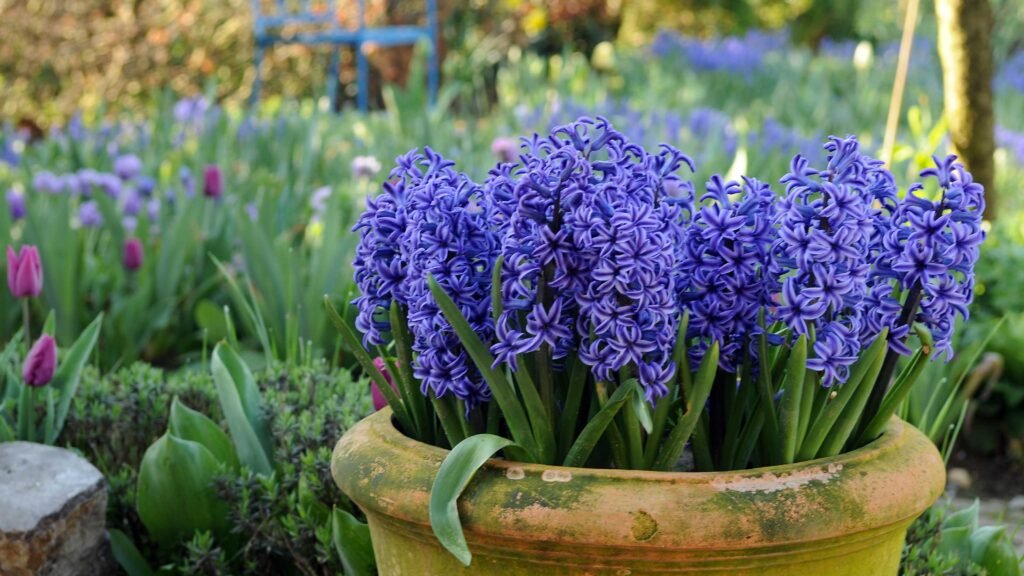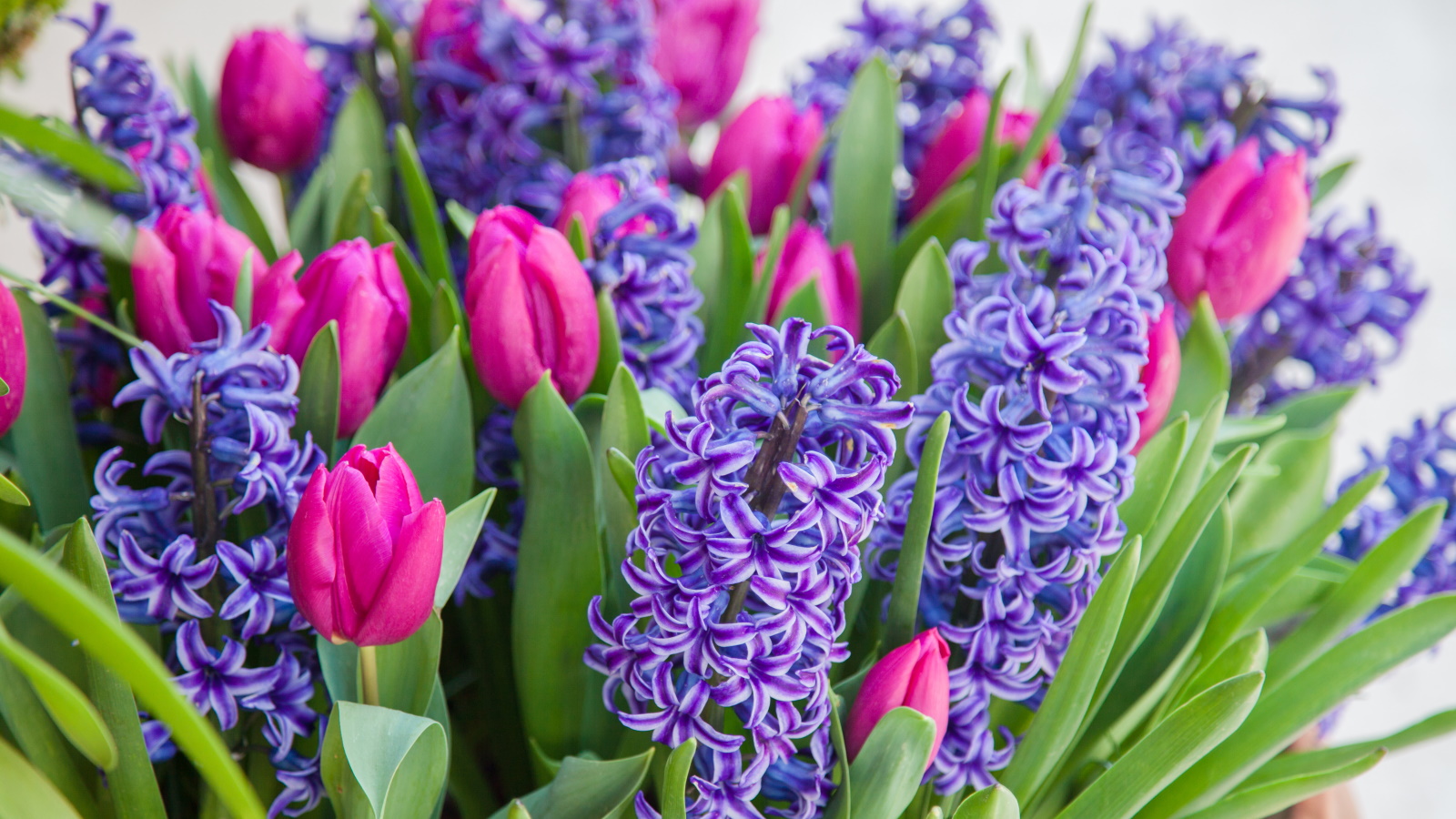
🌸 How to Plant Hyacinth Bulbs: The Complete Guide to Growing Fragrant Spring Blooms
There’s something magical about stepping into a garden in early spring and catching the sweet, rich scent of hyacinths. These colorful, fragrant flowers are one of the highlights of the season—bursting out of the cold ground with vibrant clusters of blooms that look almost too perfect to be real.

Whether you’re planting them in the ground, growing them in pots, or forcing them indoors for some winter cheer, hyacinth bulbs are surprisingly easy to grow—as long as you get the basics right. In this comprehensive guide, we’ll walk you through everything you need to know to plant, grow, and care for hyacinths, so you can enjoy their beauty and fragrance year after year.
🌱 Why Plant Hyacinths?
Hyacinths are more than just pretty flowers. Here’s why gardeners love them:
- 🌸 Fragrance: Their sweet perfume is one of spring’s signature scents.
- 🌈 Color variety: From pinks, purples, and blues to whites, yellows, and even deep reds.
- 💡 Easy to grow: Low-maintenance once planted properly.
- 💐 Great for borders and containers: They fit perfectly in beds, pots, or even window boxes.
- 🏠 Indoor beauty: They can be “forced” to bloom indoors during the winter.
🌼 When to Plant Hyacinth Bulbs
Timing is everything when it comes to bulbs.
- The ideal time to plant hyacinth bulbs is in fall, about 6 to 8 weeks before the first expected hard frost.
- This gives the bulbs enough time to establish roots before the ground freezes.
- In most climates, that means planting them in September to November.
Pro Tip: Chill the bulbs in your fridge for 6–8 weeks if you’re in a warmer zone (USDA zone 9 and above) where the ground doesn’t get cold enough.
🧾 What You’ll Need
Before you start digging, make sure you have these essentials:
- Healthy hyacinth bulbs
- A garden trowel or bulb planter
- Well-draining garden soil or potting mix
- Compost or bulb fertilizer (optional but helpful)
- Gardening gloves (hyacinth bulbs can irritate skin)
- Watering can or hose
🪴 Step-by-Step: How to Plant Hyacinth Bulbs Outdoors

Planting hyacinths in the garden is simple if you follow these steps:
1. Choose the Right Spot
Hyacinths love sunshine! Pick a spot that gets full sun to partial shade—at least 4–6 hours of direct light per day.
Make sure the soil drains well. Bulbs don’t like soggy conditions, which can lead to rot.
2. Prepare the Soil
Loosen the soil to a depth of 8–10 inches. Mix in compost or a bulb-specific fertilizer if your soil is lacking in nutrients.
Avoid heavy clay or overly wet soil. If that’s your only option, plant in raised beds or containers instead.
3. Plant the Bulbs
- Depth: Plant each bulb 4–6 inches deep, with the pointed end facing up.
- Spacing: Leave about 3–5 inches between bulbs.
- Groups or rows: Plant in clusters for a more natural look and better visual impact.
4. Water Gently
After planting, give the area a good, deep watering to help settle the soil around the bulbs and kickstart root development.
You don’t need to water them regularly through winter unless your area is going through an unusually dry spell.
5. Mulch (Optional)
Applying a light mulch can help insulate the bulbs and protect them from sudden cold snaps. Just be sure to remove it in early spring so the shoots can break through easily.
🌿 Growing Hyacinths in Containers

Short on space? You can still enjoy hyacinths on balconies, patios, or windowsills.
Container Planting Tips:
- Use a pot with good drainage—hyacinths hate soggy soil.
- Fill with a light, well-draining potting mix.
- Plant bulbs about 4 inches deep and 2–3 inches apart.
- Water after planting, and keep them in a cool, shaded spot until spring.
Containers can be moved around easily—bring them closer to your entryway or indoors once the blooms appear!
🏡 Forcing Hyacinths Indoors
Want beautiful, fragrant flowers in the dead of winter? Forcing hyacinth bulbs indoors is a fun and easy project.
Forcing Steps:
- Chill bulbs in the fridge for 6–8 weeks (keep them away from apples—they emit ethylene gas that damages bulbs).
- Plant in pots with the tip just above the soil line.
- Water well and place in a cool, dark place (around 40–50°F) for root development.
- After roots develop (4–6 weeks), bring the pot into bright indoor light.
- Watch as they bloom indoors—often by late winter!
💧 Watering and Feeding Hyacinths
Hyacinths don’t need a lot of fuss once they’re planted.
- Watering: After initial watering, you only need to water if the fall or winter is dry.
- Spring: Once shoots appear, resume watering if the soil dries out.
- Fertilizer: A bulb-boosting fertilizer in fall (and again as flowers fade) helps the bulb store energy for next year.
✂️ Aftercare: What to Do After Blooming

Once your hyacinths have put on their colorful show, here’s how to care for them post-bloom:
- Deadhead the flowers (cut off the bloom stalk) once the flowers fade. This prevents the plant from wasting energy making seeds.
- Leave the leaves! The foliage will turn yellow over several weeks—don’t cut it back until it’s completely withered. The leaves feed the bulb for next season’s bloom.
- Dig up or leave in place: In cold climates, you can leave hardy bulbs in the ground. In warmer zones or with forced bulbs, you may want to dig them up and store them in a cool, dark, dry place until next fall.
🛡️ Common Problems & How to Fix Them
| Issue | Cause | Solution |
|---|---|---|
| Bulbs rotting | Poor drainage or overwatering | Improve soil or use raised beds |
| No flowers or weak blooms | Not enough chilling or planted too late | Chill bulbs, plant earlier |
| Yellow leaves before bloom | Too much water or poor soil | Reduce watering, improve drainage |
| Aphids or fungal spots | Pest or disease | Treat with neem oil or fungicide |
Regularly inspect your bulbs, especially in containers, to catch problems early.
Table of Contents
❓ Frequently Asked Questions
Q: Can I plant hyacinth bulbs in spring?
Not really. Hyacinths need cold to develop properly. If you plant them in spring, they likely won’t bloom. You can try forcing pre-chilled bulbs indoors instead.
Q: Are hyacinths toxic to pets?
Yes, especially the bulbs. Keep them out of reach of dogs and cats, and always wear gloves when handling them—they can irritate human skin too.
Q: How long do hyacinth blooms last?
About 1–2 weeks outdoors, and slightly less indoors. Cooler weather will help the flowers last longer.
Q: Can I reuse bulbs year after year?
Yes! With proper care (especially letting the foliage die back naturally), hyacinths will return for several years, although they may bloom less dramatically over time.
Q: How many bulbs should I plant?
For a nice visual impact, plant hyacinths in groups of 5 to 10 bulbs. A single bulb looks a little lonely on its own!
✅ Conclusion: Why Hyacinths Are Worth Planting Every Fall
Hyacinths are one of the easiest and most rewarding spring bulbs you can grow. With just a little effort in the fall, you’ll be greeted in early spring by clusters of jewel-toned flowers and a fragrance that stops you in your tracks. Whether you’re adding color to your flower beds, brightening up containers, or bringing cheer indoors during winter, hyacinths never disappoint.
They’re low-maintenance, beautiful, and offer reliable blooms for years. Just remember to plant them deep, keep the soil well-drained, and give them the chill they need to thrive. Once you’ve planted your first batch, you’ll wonder how you ever lived without them.
So go ahead—grab a handful of bulbs, dig in, and get ready for a spring garden that smells as good as it looks. 🌷
🧾 Quick Recap: Hyacinth Planting at a Glance
| Task | Details |
|---|---|
| When to Plant | Fall (6–8 weeks before frost) |
| Soil Requirements | Well-draining, neutral pH |
| Sunlight | Full sun to partial shade |
| Planting Depth | 4–6 inches |
| Spacing | 3–5 inches apart |
| Watering | Deeply after planting, then as needed |
| Post-bloom Care | Remove blooms, leave foliage |
| Indoor Forcing | Chill bulbs, then plant |
